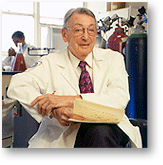The Robert F. Furchgott Society

During the 1950s, the late Dr. Robert Furchgott developed a method for determining how blood vessels respond to medications, neurotransmitters, and hormones, using a piece of rabbit aorta cut in the form of a helix. This novel methodology allowed him to determine the effects of drugs on vascular smooth muscle. In his early research he discovered that vascular smooth muscle relaxes when exposed to ultraviolet light, a phenomenon known as photo-relaxation.
Dr. Furchgott's major research advances came in 1980, when he discovered a substance produced by endothelial cells that caused relaxation of the vascular smooth muscles. He called this substance endothelium-derived relaxing factor (EDRF). This substance was later identified as nitric oxide. On October 12, 1998, Dr. Furchgott received the Nobel Prize for Physiology or Medicine.
In honor of Dr. Robert Furchgott's work, the Robert F. Furchgott Society was established in 2005. The Society supports graduate students and fellows conducting basic science studies in a broad array of subjects. Each year, one exceptionally talented graduating PhD and one medical student is honored with The Robert F. Furchgott Award for Excellence in Research. The Society also provides annual travel awards to deserving clinical and/or basic science research fellows, to underwrite the cost of presenting their research at national or international conferences. The Society has also established an Annual Visiting Professorship Lecture that brings outstanding scientists to the Downstate campus to participate in seminars and roundtable discussions.
To become a member of the Robert F. Furchgott Society call (718) 270-4418 to join or make a gift online.